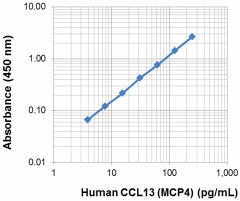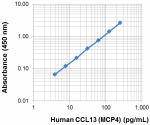- Clone
- 8C12 (See other available formats)
- Regulatory Status
- RUO
- Other Names
- Monocyte chemeotactic protein 4 (MCP4), CKβ10, New CC chemokine 1 (NCC1), Small inducible cytokine subfamily a, member 13 (SCYA13)
- Isotype
- Mouse IgG1, κ
- Ave. Rating
- Submit a Review
- Product Citations
- publications

| Cat # | Size | Price | Quantity Check Availability | Save | ||
|---|---|---|---|---|---|---|
| 537704 | 100 µg | $265 | ||||
Human CCL13 (MCP-4) was initially identified in a library constructed from human fetal mRNA. CCL13 shares a high similarity with CCL2 (MCP-1, 61%), CCL7 (MCP-3, 58%), and CCL8 (MCP-2, 55%). CCL13 is constitutively expressed at high levels in the small intestine, colon, and lung. Original data showed that CCL13 was less effective than MCP-1 and MCP-3 in monocyte and lymphocyte chemoattraction, but equivalent to eotaxin as a chemoattractant for eosinophils. Chemokines are very important in the inflammatory process, initially in the influx of PMN by CXC chemokines and subsequently chemoattracting monocytes where the MCPs participate, including CCL13. The bioactivity of pro-inflammatory chemokines is regulated by MMPs in order to regulate the influx of different cell subpopulations. In the case of CCL13, it is inactivated by MMP-12 by truncation at position 4-5 generating a CCR antagonist and decreasing the arrival of monocytes. CCL13 binds to CCR2, and this receptor also binds to CCL2, CCL8, CCL7, CCL11, CCL24, and CCL26. CCL13 is involved in inflammatory diseases such as rheumatoid arthritis (RA), atherosclerosis, and asthma. High levels of CCL13 have been detected in the synovial fluid of patients with RA, in serum of asthmatic patients, and in plasma of patients with symptomatic carotid atherosclerosis.
Product DetailsProduct Details
- Verified Reactivity
- Human
- Antibody Type
- Monoclonal
- Host Species
- Mouse
- Immunogen
- Recombinant protein
- Formulation
- Phosphate-buffered solution, pH 7.2, containing 0.09% sodium azide.
- Preparation
- The antibody was purified by affinity chromatography and conjugated with biotin under optimal conditions.
- Concentration
- 0.5 mg/ml
- Storage & Handling
- The antibody solution should be stored undiluted between 2°C and 8°C. Do not freeze.
- Application
-
ELISA Detection - Quality tested
- Recommended Usage
-
Each lot of this antibody is quality control tested by ELISA assay. For ELISA Detection applications, a concentration range of 0.2 - 2 µg/mL is recommended. To obtain a linear standard curve, serial dilutions of CCL13 (MPC4) recombinant protein ranging from 3.9 to 250 pg/mL is recommended for each ELISA plate. It is recommended that the reagent be titrated for optimal performance for each application.
- Application Notes
-
The biotinylated 8C12 (Cat. No. 537704) antibody is useful as the detection antibody in a sandwich ELISA assay, paired with pure 3G4 (Cat. No. 537602) and Lyophilized CCL13 (MCP4) (Cat. No. 587509).
- RRID
-
AB_2783352 (BioLegend Cat. No. 537704)
Antigen Details
- Structure
- Chemokine
- Distribution
-
Epithelial cells, endothelial cells, fibroblasts, chondrocytes, macrophages
- Function
- CCL13 chemoattract monocytes, eosinophils, CD4, and CD8 T cells. CCL13 induces histamine release from IL-3-primed peripheral blood basophils. IFN-γ induces CCL13 in bronchial epithelial cell lines, endothelial cells, and chondrocytes, and a synergistic effect is obtained with INF-γ and TNF-α or IL-1 in chondrocytes. CCL13 is processed and inactivated by MMP-12.
- Interaction
- Monocytes, dendritic cells, basophils, eosinophils, T cells
- Ligand/Receptor
- CCR2, CCR3, and CCR5
- Cell Type
- Endothelial cells, Epithelial cells, Fibroblasts, Macrophages
- Biology Area
- Cell Biology, Signal Transduction
- Molecular Family
- Cytokines/Chemokines
- Antigen References
-
- Uguccioni M, et al. 1996. J. Exp. Med. 183:2379.
- Godiska R, et al. 1997. J. Leuko. Biol. 61:353.
- Kalayci O, et al. 2004. J. Asthma 41:27.
- Iwamoto T, et al. 2007. FEBS J. 274:4904.
- Mendez-Enriquez E, et al. 2008. Clin. Exp. Immunol. 152:354.
- Hintzen C, et al. 2009. Arthritis Rheum. 60:1932.
- Dean RA, et al. 2008. Blood 112:3455.
- Breland UM, et al. 2010. Cardiovasc. Res. 86:265.
- Gene ID
- 6357 View all products for this Gene ID
- UniProt
- View information about CCL13 on UniProt.org
Related FAQs
- How many biotin molecules are per antibody structure?
- We don't routinely measure the number of biotins with our antibody products but the number of biotin molecules range from 3-6 molecules per antibody.
Other Formats
View All CCL13 Reagents Request Custom Conjugation| Description | Clone | Applications |
|---|---|---|
| Biotin anti-human CCL13 (MCP-4) | 8C12 | ELISA Detection |
Compare Data Across All Formats
This data display is provided for general comparisons between formats.
Your actual data may vary due to variations in samples, target cells, instruments and their settings, staining conditions, and other factors.
If you need assistance with selecting the best format contact our expert technical support team.
 Login/Register
Login/Register 













Follow Us